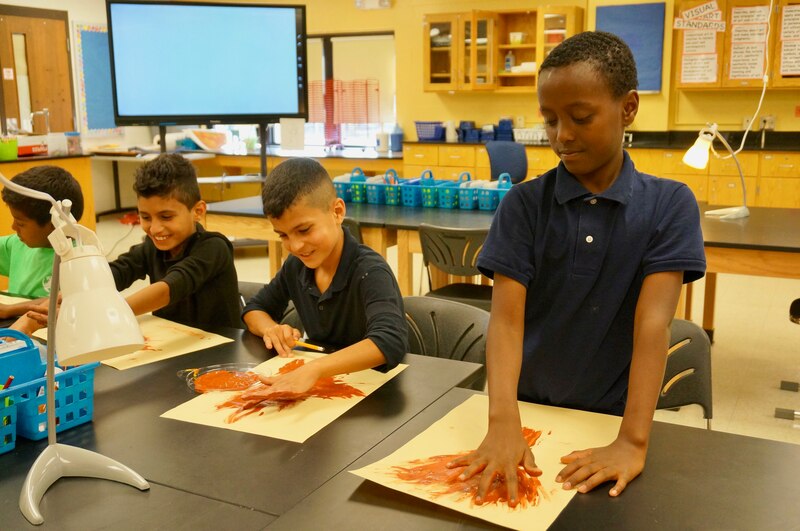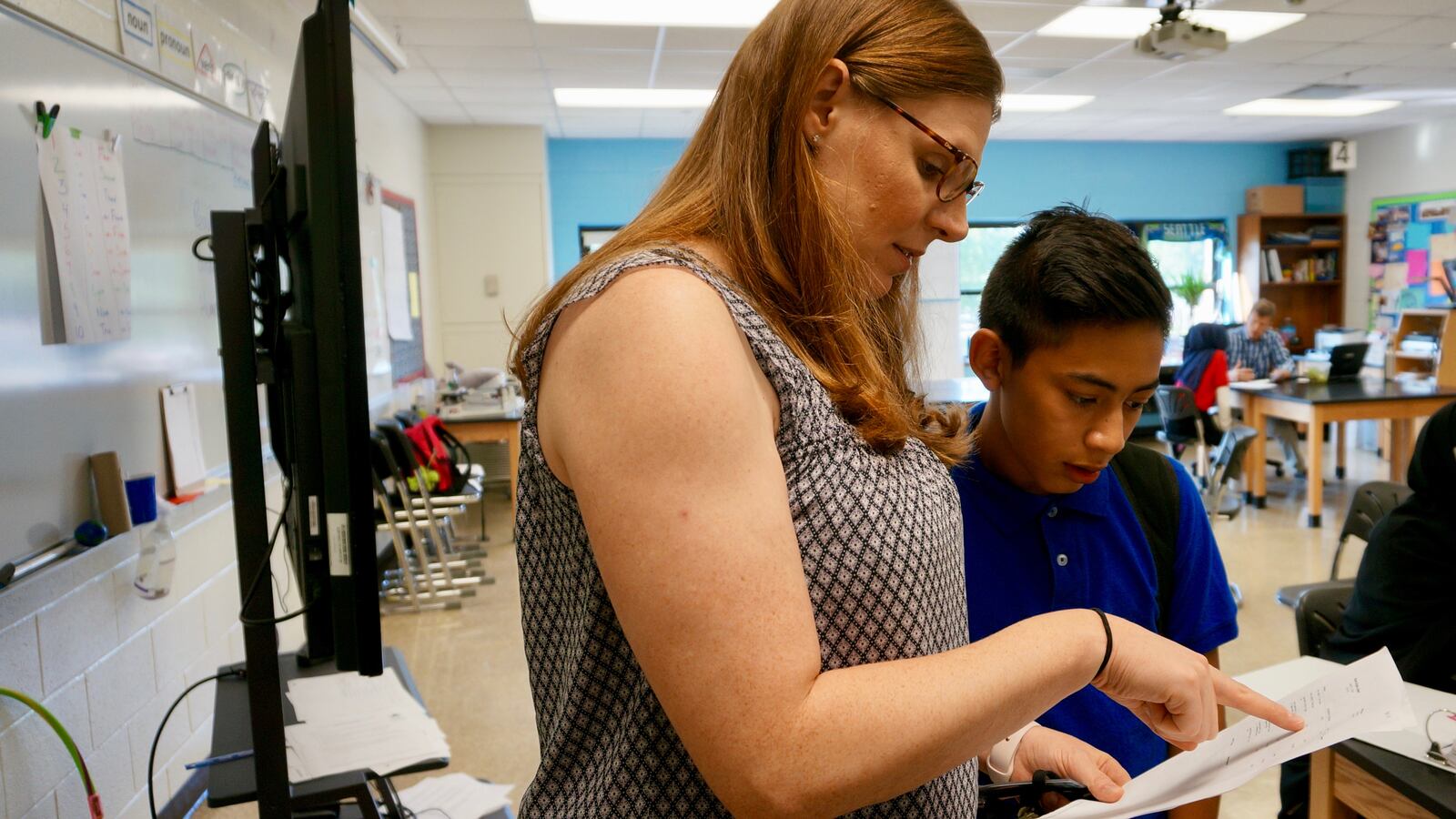When the Indianapolis Public Schools newcomer program opened its doors last year, there was a burst of enrollment, with new students trickling in throughout the year.
But with the Trump administration’s months-long ban on refugee admissions, the school — and the students it serves — are facing new challenges this year. Fewer students than expected are enrolling in the program, and many of the families at the school are living in fear of deportation.
“We felt like kids were coming out of the woodwork because this place had been built for them,” said Amanda Clayton, who runs the program. Now, she said, “I feel like a lot of our families are having to go back into the shadows.”
The changed circumstances of the newcomers program — the district’s attempt at making immigrant children feel more welcome, as well as improving their chances of success in the system — is a reflection of how much the immigration picture in the United States has shifted since the election of President Trump. For some, it is a window into the lives of immigrant children and their families at a time when the country is riven over how wide to open its doors and what to do with those already here.
The newcomer program is designed to help students who are new to the United States acclimate and learn English before transitioning to other IPS schools. Most of the students are Spanish speaking immigrants and asylum seekers, but a large minority are refugees from around the globe. Now in its second year, the campus added elementary grades this year, expanding to include students in 3rd to 9th grades.
The program prepared for up to 300 children, Clayton said, but this year enrollment has been slower than staff expected. Currently, it has 160 students. (It admits new students throughout the year, however, and its enrollment has grown by about 42 children since July.)

It’s hard to predict enrollment at the school because it depends heavily on immigration to the city, Clayton said. There are other reasons behind the low enrollment, she said, such as lower than expected interest in the elementary program because many families are happy with neighborhood schools. But one of the most significant reasons enrollment is unexpectedly low is because there are far fewer refugees resettling in Indianapolis.
Since President Trump took office, the number of refugees admitted to the U.S. has plummeted. From January through September 2017, about 28,000 refugees were admitted to the country — fewer than half the number that were admitted during the same period in 2016, according to State Department data.
The decline in refugees coming to Indianapolis steepened this summer when the administration stopped processing new refugee applications, said Elizabeth Standiford, director of development and communications for Exodus Refugee Immigration of Indianapolis. Although some refugees were still allowed in the country, resettlements in Indianapolis fell drastically, she said. Last October, for example, Exodus resettled 164 refugees. During the same month this year, the agency resettled just seven people.
In an interview in September, Jessica Feeser, who oversees English language learning for IPS, said she expected to see enrollment grow again with the admission of more refugees to the U.S.
“When that, hopefully, ban is lifted, we will be able to welcome families to IPS,” she said, referring to the halt on refugee processing. “I think this is temporary.”
In fact, President Trump lifted the suspension on admitting new refugees on Oct. 24. But the administration is imposing additional restrictions on refugees from 11 countries, and it has also drastically lowered the number of refugees it plans to admit.
It’s unclear how those changes will affect Indianapolis or the newcomer program. Exodus is expecting the number of refugees resettled in the city to remain relatively low over the next few months, Standiford said.
“We don’t really know how quickly the program will get going again with the new restrictions,” she added. “We have the worst refugee crisis the world has ever seen, right, and the U.S. has pulled back on welcoming refugees.”
Since Trump took office in January, the administration has waged a campaign to reduce immigration to the U.S., arguing, among other things, that public safety and jobs for natural born Americans are at stake. Much of the resistance also has been focused on concerns about public spending for immigrants, particularly those who have entered the country illegally.
Indiana politicians have supported similar positions in recent years, including under the governorship of Mike Pence, who is Trump’s vice-president. In 2015, Pence refused to resettle Syrian refugees in Indiana, a move that was blocked by a federal appeals court following a case brought by Exodus. In 2011, state lawmakers barred governmental bodies from refusing to cooperate with federal immigration authorities.
The newcomer school, however, has not been the focus of vocal criticism. Several state lawmakers who have introduced legislation to prevent education institutions from becoming “sanctuary” campuses declined to comment on the program.
In contrast to state policymakers, Indianapolis leaders have vocally welcomed immigrants. The IPS school board approved the newcomer program unanimously, and it has passed two resolutions in support of undocumented students over the last eight months. That support has also been financial: Despite the lower than expected enrollment in the newcomer program this year, Superintendent Lewis Ferebee has maintained the school’s funding and staff.
The support the program has gotten from the district sends a message to the community, Clayton said, including, “We are not going to close our doors on this population.”
But many families are still afraid, Clayton said. Once they turn 18, students seeking asylum in the U.S. routinely come to school with ankle bracelets so immigration officials can monitor their location. One mother’s children missed several days of school because she was unsure where the bus stop was, and she was afraid to leave her home to find it.
“Last week, one of our student’s dads, he was deported,” she said during an interview in September. “She didn’t know that day that she was going to go home and that was going to be the case.”
But despite the challenges that federal immigration policy has imposed on the newcomer program’s families and staff, the slow start to the school year had advantages, Clayton said. Classes were smaller (about 15 students per class in high school), so it was easier to show students how the school works. Teachers were able to get their bearings.
As Clayton walked through the school on a Friday in September, the halls were quiet and calm. But inside classrooms, students were boisterous and friendly.
When Clayton walked through a high school advisory period, students clustered around her to show off their grades. Many of the students at the school aren’t familiar with grades, so the teachers use emojis to help translate which are good.
“B is good?” one boy asked Clayton. “Yes,” she said. “A B is good. Yes.”
The school is designed to be small, so staff can build close relationships with students. And as Clayton walks through classes, it’s clear that she knows what’s going on with most of the teens. She knows why the students came to the U.S., who they are living with, and where they used to go to school.
Clayton comes across another boy who started at the newcomer program last year. His grades jumped this year, she said.
“This is amazing,” she told him. “I’m really proud of you”
The atmosphere is a contrast with the high schools where these students would likely enroll if they were not in the newcomer program, said Katherine Hinkle, a literacy coach at the school. Hinkle used to teach at Northwest High School, a large, traditional IPS campus that serves many newcomer students. The campus wasn’t equipped to support those teens, she said.
At newcomer, students can get personal attention and slowly acclimate to school in America, she said.
“Kids are coming in and this is their first impression of school in the United States,” she said. “The culture is automatically, ‘everyone works. Everyone tries. It’s O.K. to make mistakes. This is how we do things.’ ”

